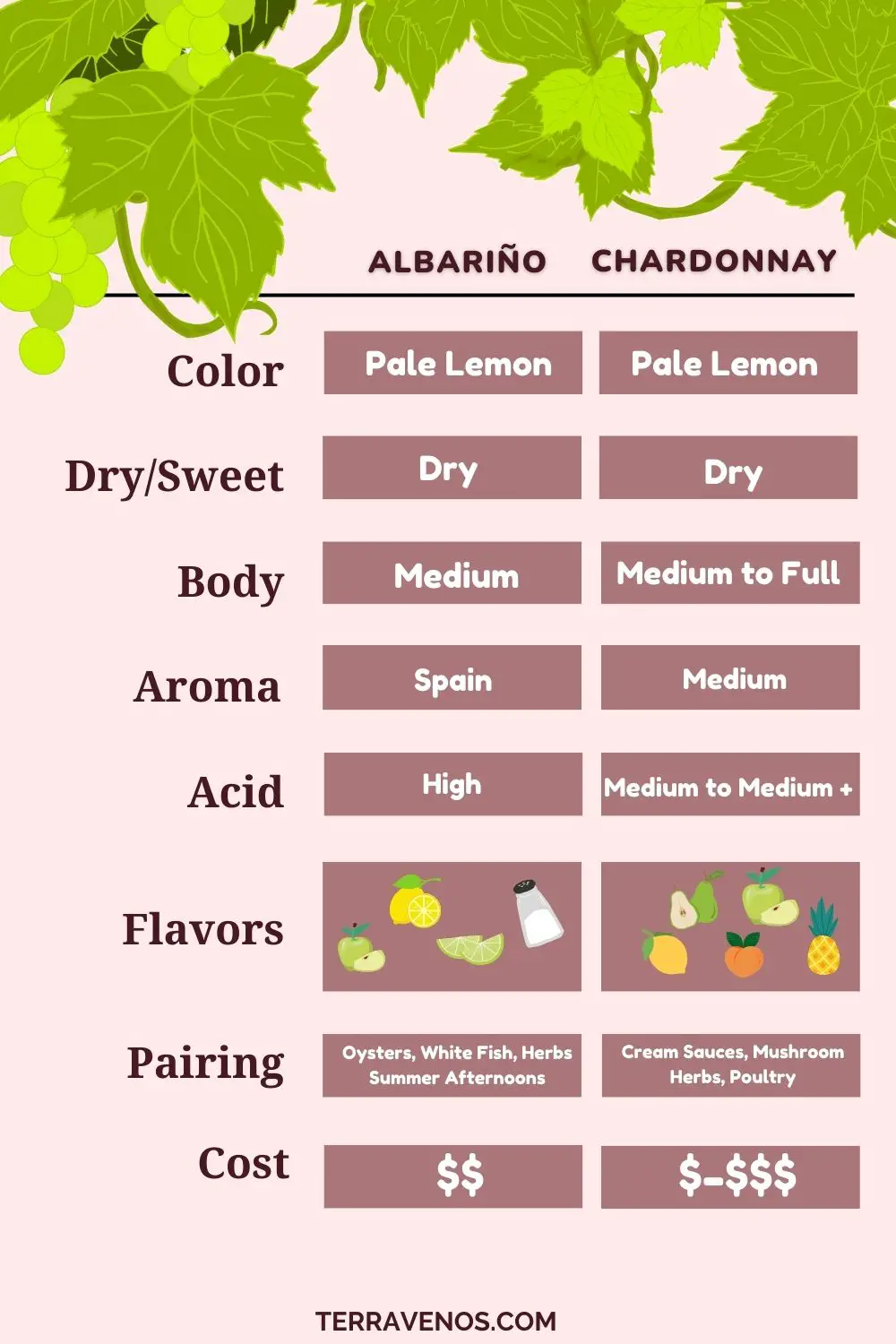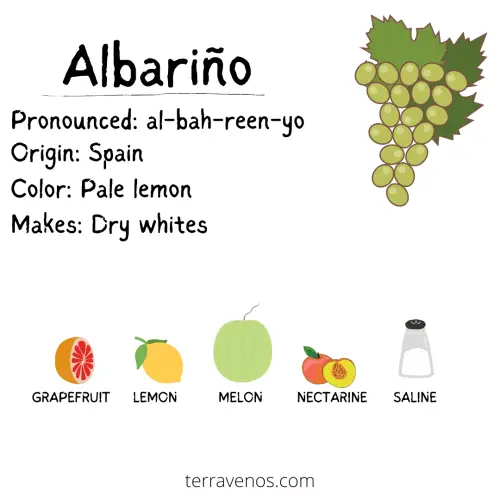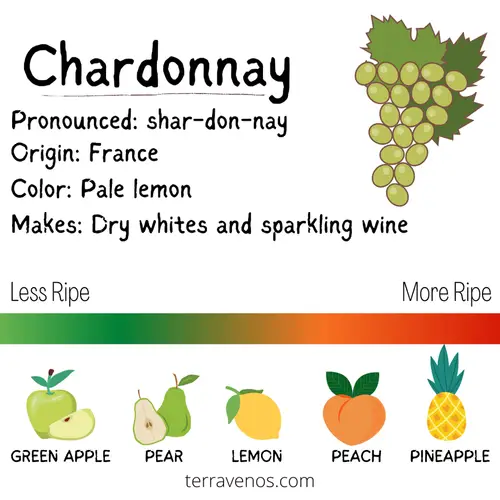
Albariño vs Chardonnay is a great white wine comparison because, depending on the Chardonnay’s winemaking style, the two can seem similar.
Albariño is a dry, leaner, citrus-driven white wine with high acid. Chardonnay is a fuller-bodied white wine with a range of favors, from citrus to tropical and buttery vanilla.
TL;DR: If you love Albariño, you may like some styles of Chardonnay more than others.
Here’s what you need to know about the differences between Albariño and Chardonnay.
- Albariño Basics: Spain’s Signature White
- Chardonnay Basics: Classic White Wine
- Albariño vs Chardonnay: Winemaking
- Albariño vs Chardonnay: Food Pairings and Serving Temperature
- Which Is More Expensive, Albariño vs Chardonnay?
- Which Is Better: Albariño or Chardonnay?
- Final Thoughts – Albariño or Chardonnay?
Albariño Basics: Spain’s Signature White

Albariño, a gem from Spain’s Rías Baixas region in Galicia, captures the essence of its maritime terroir. This zesty white wine boasts a vibrant acidity, with grapefruit, lemon, lime, melon, and white nectarine. You may even detect a hint of saline.
Its crisp and invigorating profile makes it a perfect companion for seafood dishes. Think oysters, fish and chips, ceviche, and more.
In Rías Baixas, where Albariño reigns supreme, the wine reflects the region’s coastal charm. The combination of cool ocean breezes and mineral-rich soils imparts a unique character to the grapes, resulting in wines that embody the spirit of the Galician coastline. Helpful Tip: Go check out this post for a deep dive into Albariño wine.
Fun Wine Fact: The name “Albariño” is derived from the word “Alba,” which means white in Galician, reflecting the grape’s light color.
Chardonnay Basics: Classic White Wine

Chardonnay is the most popular white wine in the world. Chardonnay crafts wines that differ depending on the growing climate, from steely and acidic with minerality, to luscious stone and tropical fruits.
Chardonnay is often called a winemaker’s grape because the winemaker can play with different winemaking techniques to make different styles of Chardonnay.
Helpful Tip: Go check out this complete guide to Chardonnay wine.
Wine Comparison: Albariño vs Chardonnay
Here’s a side-by-side comparison highlighting the key differences and similarities between Albariño and Chardonnay.
| Characteristics | Albariño | Chardonnay |
|---|---|---|
| Hue | Pale to medium lemon | Pale lemon to deep gold |
| Color | White | White |
| Aromas | Citrus, peach, apricot, saline | Apple, pear, buttery, vanilla, tropical |
| Sweetness | Dry | Dry to off-dry |
| Acid | High | Medium to high |
| Alcohol (%) | 11-13% | 13-15% |
| Body | Light to medium | Medium to full |
| Intensity | Medium to medium plus | Medium to pronounced |
| Key Growing Regions | Spain (Rias Baixas), Portugal, California | France (Burgundy, Chablis), California, Australia – Most major winegrowing regions |
| Classic Pairings | Seafood, shellfish, light salads, grilled veggies | Chicken, seafood, creamy dishes |
| Price Range | $15-$30 | $10-$50 |
Albariño Wine Profile
- Sweetness: Albariño wines tend to be dry, offering little to no residual sugar.
- Alcohol: Typically, Albariño wines have a moderate alcohol content, ranging from around 11% to 13% ABV.
- Body: Albariño wines generally have a medium body, providing a satisfying weight on the palate, but lighter than many Chardonnays.
- Acid: Albariño is renowned for its vibrant acidity, which adds freshness and liveliness to the wine, usually higher than most Chardonnay wines.
- Aroma and Intensity: Albariño boasts pronounced flavors and aromas, with a focus on citrus notes, especially lemon and lime.
- Flavors: In addition to citrus, Albariño often exhibits flavors of green apple, peach, apricot, and sometimes a hint of saline minerality.
Chardonnay Wine Profile
- Sweetness: Chardonnay wines cover the spectrum from bone-dry to off-dry. Less expensive Chardonnay often has a little residual sugar from unfermented grape juice in it for sweetness.
- Alcohol: Chardonnay wines generally have a moderate alcohol content, ranging from around 12% to 14% ABV.
- Body: Chardonnay exhibits a diverse range of body, from light and crisp to full and creamy, depending on winemaking choices.
- Acid: Chardonnay can showcase a broad spectrum of acidity, from vibrant and zesty to more rounded and soft.
- Flavor and Aroma Intensity: Chardonnay’s profile varies widely, with notes of green apple, citrus, tropical fruit, and sometimes hints of vanilla and butter.
- Styles: Styles range from unoaked, highlighting bright fruit, to oaked, introducing creamy textures and nuances of oak influence.
Are Albariño and Chardonnay Similar?
Yes, Albariño and Chardonnay are similar. A high acid, unoaked Chardonnay will be lighter in body and have similar citrus notes as an Albarino.
Fun Wine Tip: A fun wine comparison would be to taste 1 Albarino, 1 Chablis (Chardonnay from France), and 1 buttery Chardonnay from California.
What Is the Difference Between Albariño and Chardonnay?
Albariño is higher in acid and lighter in body than most Chardonnay wines. Albariño has a distinctive saline and mineral note. Chardonnay wines are often oaked, giving them distinctive vanilla and spice.
Albariño vs Chardonnay: Winemaking
Winemakers commonly ferment both Albariño and Chardonnay in stainless steel tanks, preserving their freshness and fruit-forward flavors. Chardonnay, however, can be fermented or aged in oak, giving it a rounder mouthfeel, more texture, and toasty notes.
Fun Fact: Here’s what oak adds to wine.
Albariño vs Chardonnay: Food Pairings and Serving Temperature

- Chardonnay’s fuller-body makes it an excellent companion for richer dishes, including creamy pasta and oven-roasted poultry.
- Albariño’s clean and linear character makes it a versatile partner for seafood, light pasta dishes, white meats, and mild cheeses. It’s also a fantastic wine for sipping on a warm afternoon.
Helpful Tip: If you’re just getting started with wine, head over to the post that covers just the basics of food and wine pairing.
Albariño and Chardonnay Serving Temperature
| Wine | Ideal Serving Temperature |
|---|---|
| Albariño | Well-Chilled (around 45-50°F or 7-10°C) |
| Chardonnay | Chilled (around 50-54°F or 10 -12°C) |
Both Albariño and Chardonnay are best served chilled, allowing their refreshing qualities to shine through. Take them out of the fridge and enjoy.
Most Albariño and Chardonnay wines are ready to drink immediately after opening, with no need for decanting or extended aeration.
Which Is More Expensive, Albariño vs Chardonnay?
It’s natural to want to compare costs when comparing wines.
Albariño Cost
- Entry-level Albariño wines also come at accessible prices, usually falling within the $10 USD range per bottle. These wines are known for their vibrant acidity and refreshing characteristics, making them versatile for casual sipping or food pairing.
- On the premium side, Albariño reveals its elegance and expressive flavors. Premium Albariño wines, sourced from renowned regions, can be priced from $25 to $50 or even higher, delivering a memorable drinking experience.
Chardonnay Cost
- Chardonnay, with its widespread availability, caters to various budgets. Entry-level Chardonnays are accessible, often in the $8-$12 USD range.
- A higher quality bottle, for example, a 90+ point Chardonnay from Burgundy, France, starts around $35 USD, but you can find beautiful 90+ Chardonnays from other regions for under $20 USD as well. Shop around!
Helpful Tip: Chardonnay and Albarino are both wines that you’ll find at your local grocery store. Check out this post for 9 quick tips on how to buy great grocery store wines.
Which Is Better: Albariño or Chardonnay?
If you enjoy a zesty and vibrant wine with citrus and tree fruit, try Albariño. If you enjoy fuller-bodied white wines with rich oak and butter, then Chardonnay is better. If you’re concerned about price, you’ll find entry-level Chardonnays that are less expensive than Albarino.
Final Thoughts – Albariño or Chardonnay?
Both Albariño and Chardonnay are lovely wines with unique personalities. Ready to get started comparing the two?
- Hosting a side-by-side tasting is the best way to explore the differences between these two classic white wines.
- Get yourself 2 bottles of similarly priced Albariño and Chardonnay, invite a few friends over, and do your own tasting.
Albariño presents a lively and refreshing profile with a saline kiss, making it a fantastic choice for warm days and light dishes. Chardonnay, with a softer personality, can seem similar to Albarino depending on the hand of the winemaker.
Discover More:
Viognier vs Riesling
Pinot Grigio vs Albarino
Chardonnay vs Pinot Grigio
Gruner Veltliner vs Riesling
Pinot Grigio vs Vermentino
Thirsty for More?
If you’re eager to delve further into the world of wine, consider hosting your own wine tasting for beginners.
Explore other side-by-side comparisons such as Sauvignon Blanc vs. Chardonnay, and delve into the signature wines from famous wine regions worldwide.




